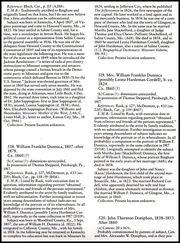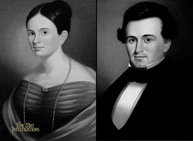The Correction
Introduction

Oil on Canvas, 24 x 20 inches
The Huntington Library, Art Collections, and Botanical Gardens
Given in Memory of Maurice Bloch and of Blake Nevius, friends of the artist.
This is the third of four blogs about the re-discovered George Caleb Bingham portraits of William Franklin Dunnica and Martha Jane Shackelford Dunnica.
The work of E. Maurice Bloch (1925-1989), the world’s acknowledged expert on artist George Caleb Bingham (1811-1879), is awe-inspiring. At the University of California Los Angeles, where he was a professor of art history, he was known for his “meticulous scholarship and connoisseurship.” Without the aid of the Internet, and for most of his research not even a computer, he compiled a wealth of information currently stored at the Getty Research Institute. He wrote four authoritative books on George Caleb Bingham. Of the four, his masterpiece is, in my opinion, his final Bingham Catalogue Raisonné: The Paintings of George Caleb Bingham: A Catalogue Raisonné (University of Missouri Press, 1986).((David Rodes and Anthony Vidler, “E. Maurice Bloch, Art History: Los Angeles,” calisphere.org, http://texts.cdlib.org/view?docId=hb5g50061q;NAAN=13030&doc.view=frames&chunk.id=div00015&toc.depth=1&toc.id=&brand=calisphere, accessed January 2019; E. Maurice Bloch’s books on George Caleb Bingham are: George Caleb Bingham: The Evolution of an Artist (Berkeley, CA: University of California Press, 1967); and, George Caleb Bingham: A Catalogue Raisonné (Berkeley, CA: University of California Press, 1967); The Drawings of George Caleb Bingham, with a Catalogue Raisonné (University of Missouri Press, 1975);The Paintings of George Caleb Bingham : A Catalogue Raisonné (Columbia, MO : University of Missouri Press, 1986). The latter two works expand on the earlier books, but the original texts still contain valuable information about the Missouri Artist.))
Bingham Catalogue Raisonné Categories
The Paintings of George Caleb Bingham is still the definitive work on George Caleb Bingham. So, when companion portraits of William Franklin Dunnica and his wife Martha Jane Shackelford came to my attention, the first place I looked was the Bingham Catalogue Raisonné. I found the two Dunnica portraits listed in the back pages, in Category D., “Attributed Paintings.”
In his Catalogue Raisonné, Bloch divided 562 artworks into four categories:
| A. Dated Extant and Recorded Paintings | 430 |
| B. Undated Recorded Paintings | 21 |
| C. Fragmentary References to Paintings | 8 |
| D. Attributed Paintings | 91 |
| E. Copies after Bingham | 12 |
| Total | 562 |
Over the years, Category D. has become the kiss of death. Each painting listed there that I have personally seen reinforced Bloch’s classification. But the Dunnica portraits were easily recognizable Binghams with impeccable provenance. Art historical documentation and connoisseurship solidified the authentication. How could Bloch have relegated such fine portraits to the dustbin of his catalogue?

George Caleb Bingham, Martha Jane Shackelford, (Mrs. William Franklin Dunnica), ca. 1837
Oil on Canvas, 24 x 29 inches Private Collection
George Caleb Bingham, William Franklin Dunnica, ca. 1837
Oil on Canvas, 24 x 29 inches Private Collection
How Did This Mistake Happen?
The short answer is: he never saw the Dunnica portraits.
The long answer is found in a close reading of Bloch’s explanatory notes.

Bloch knew of the existence of the portraits from a slim, but influential volume published in 1917, George Caleb Bingham: The Missouri Artist, by Fern Helen Rusk (1890-1984). Rusk’s book is responsible for keeping the artist’s memory alive. Rusk listed the portrait pair as Mr. and Mrs. William Franklin Dunnica with the name of the owner, but, without dates or description. When Bloch reviewed Rusk’s work, he could not locate the owner nor their direct descendants. But he knew of another Bingham painting of Martha Jane Shackelford, the first wife of William Franklin Dunnica. Bloch noted that Martha Jane’s brother, Thomas Shackelford commissioned the portrait and that it descended within the family of her brother, along with other Bingham family portraits. Although William Dunnica and Thomas Shackelford, were life-long friends, over time, their children and their children’s children lost touch with one another. By the time Bloch was updating the work of previous Bingham scholars Fern Helen Rusk and John Francis McDermott (1902-1981), their descendants did not know of the others’ existence. When Bloch asked the Shackelford descendants about other Dunnica portraits, they honestly answered that they had no knowledge of the portraits or their whereabouts.((E. Maurice Bloch, The Paintings of George Caleb Bingham: A Catalogue Raisonné (University of Missouri Press, 1986), page 263.))
I, too, found Shackelford descendants when I reviewed Bloch’s work. They generously sent me a color photograph of their portrait of Martha Jane, which I had only known through the black & white photograph in the Catalogue Raisonné.
Two Portraits of Martha Jane Shackelford Dunnica
At first glance, the previously known portrait of Martha Jane Shackelford Dunnica does not appear to be the same woman pictured in the head & shoulders companion portrait of her husband. But, on close examination, it can be seen that the hairline and ears are identical; the mouths and shoulder shapes are similar; and the sitter is wearing the same necklace in both portraits. I scrolled through my portrait image collection for 1836-1839 and could not find another necklace like it.

George Caleb Bingham, Martha Jane Shackelford (Mrs William Franklin Dunnica) ca. 1837
Oil on Canvas,24 x 29 inchesPrivate Collection
George Caleb Bingham, Martha Jane Shackelford (Mrs. William Franklin Dunnica), ca. 1838/9
Oil on Canvas, 39 x 29 Private Collection
The differences in the two portraits lay in Bingham’s increasing talent. In the later, and larger, portrait, Bingham knew to pose the head so that the nose was less prominent. The nostrils are alike. The most striking difference is the eyes. The artist had learned how to better shape and shadow eyes.

George Caleb Bingham, Martha Jane Shackelford (Mrs William Franklin Dunnica) ca. 1837
(Detail)
George Caleb Bingham, Martha Jane Shackelford (Mrs. William Franklin Dunnica), ca. 1838/9
(Detail)
The Wrong Conclusion
Since Bloch had seen the later portrait of Martha Jane Shackelford Dunnica, he logically assumed that the paintings listed in Rusk were of Dunnica and his second wife, Leona Hardeman Cordell (1807-1896). He further presumed that the companion portraits were painted near the second wedding date, June 1860. Since the Shackelford family had no knowledge of the other portraits, he concluded, “Evidently attributed to the artist by family tradition, with no substantiation.” With such reasoning, he classified the portraits of Mr. and Mrs. William Franklin Dunnica in his Bingham Catalogue Raisonné in Section D: Attributed Paintings, without ever seeing them.
The Correction
In updating E. Maurice Bloch’s The Paintings of George Caleb Bingham: A Catalogue Raisonné, the re-discovered portraits of William Franklin Dunnica and Martha Jane Shackelford (Mrs. William Franklin Dunnica) should be listed in Category A., with a date of execution of 1836-1837, with their impeccable provenance and expanded biographies. A fine addition to a well-researched, awe-inspiring volume that is almost perfect due to the efforts of an outstanding art historian, E. Maurice Bloch.
In the fourth and final blog, the stories behind the Dunnica portraits provide a window into the past that brings history to life through the details of the sitters’ lives.

